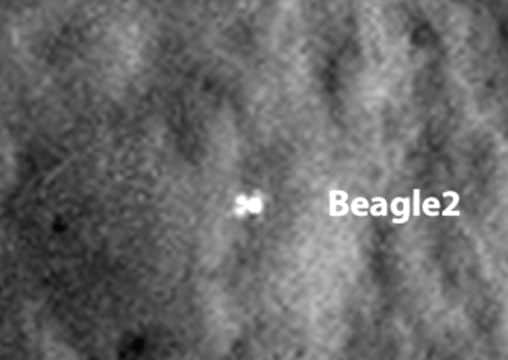Lost Beagle2 lander found ‘intact’ on Mars surface


The history books were today being rewritten following the discovery of a British built spacecraft which set out to find signs of life on Mars only to apparently vanish in the depths of space.
CONNECT WITH THE SCOTSMAN
• Subscribe to our daily newsletter (requires registration) and get the latest news, sport and business headlines delivered to your inbox every morning


Advertisement
Hide AdAdvertisement
Hide AdNew high resolution pictures from NASA have identified the probe on a vast equatorial plain on the Red Planet, proof that the beleaguered mission was, at the very least, a qualified success.
Ever since contact was with lost with the rover on Christmas Day 2003, it has become a byword for plucky British failure. A Heath Robinson-esque endeavour that married grand ambitions to a cut-price budget, it made an unlikely hero out of Professor Colin Pillinger, the Open University scientist who spearheaded the mission and assembled the probe in a garage.
Sadly, the revelation that the Beagle 2 arrived intact on Mars’ surface just a few miles from its intended landing site has come too late for the idiosyncratic planetary scientist. Prof Pillinger, who also ran a dairy farm, died last May just two days short of his 71st birthday.
His family colleagues on the venture today paid tribute to his determination to see through a project that began as a scrawl on the back of a beer mat.
When NASA’s Mars Reconnaissance Orbiter, located 185 miles above Mars, picked up some objects, it piqued the curiosity of scientists. They appeared to “glint” in the sun but cast no moving shadow.
Closer inspection revealed them to be the small lander - around the size of a motorcycle tyre - lying near the Isidis Planitia basin.
Although it made landfall, two of the device’s four crucial solar panels failed to open, prevented it from transmitting its location and data back to Earth via radio antennae.
For those who gave years of their life to the £50m initiative - a sum Prof Pillinger memorably described as the equivalent of what “NASA loses down the back of the sofa” - yesterday’s confirmation that it had partially deployed proved heartening news.
Advertisement
Hide AdAdvertisement
Hide AdMark Sims, a professor in astrobiology and space instrumentation at the University of Leicester who was mission manager of the project, said he was “elated” by the find.
“To be frank, I had all but given up hope of ever knowing what happened to Beagle 2,” he said at a press conference. “The images show that we came so close to achieving the goal of science on Mars. The images vindicate the hard work put in by many people.”
Prof Pillinger’s daughter, Shusanah, said her father would have been pleased at the success and able to “defy the critics who want to say that Beagle 2 is a failure.”
“He would have loved that this shows Beagle 2 landed on Mars, it got all the way through the entry and descend and the processes and it unravelled some of its solar panels,” she explained.
“This shows such an immense success and not forgetting all the other things that went on in the background of Beagle 2, all the promotion of science, all of the inspiration to children. He would love that this is in the news again.”
In light of the discovery, Prof Sims said it appeared the probe has sustained damage during its descent to Mars, perhaps due to a heavy landing in a thin atmosphere or because of a protective airbag becoming stuck in the mechanism. The primary factor, he added, was misfortune.
“Personally, I think it is a bad luck scenario,” he reflected. “I don’t think anything was wrong with the engineering, we were just unlucky on the day.”
With the story of the Beagle 2 given a new, upbeat epilogue, Ms Pillinger said the events and emotions of the past 24 hours were proving difficult for her family digest, but in the end, they give cause for hope and inspire a new generation to follow in her father’s footsteps.
Advertisement
Hide AdAdvertisement
Hide Ad“We are trying to carry on what dad would have wanted. He was someone who wanted science to be communicated to everybody. We want everybody to be aware of Beagle 2, to be inspired by it,” she added. “But there is a tinge of sadness that he can’t be here. You can see that in the room where all his colleagues, all the people he worked with, everybody is gutted he cannot be here.”
SCOTSMAN TABLET AND IPHONE APPS